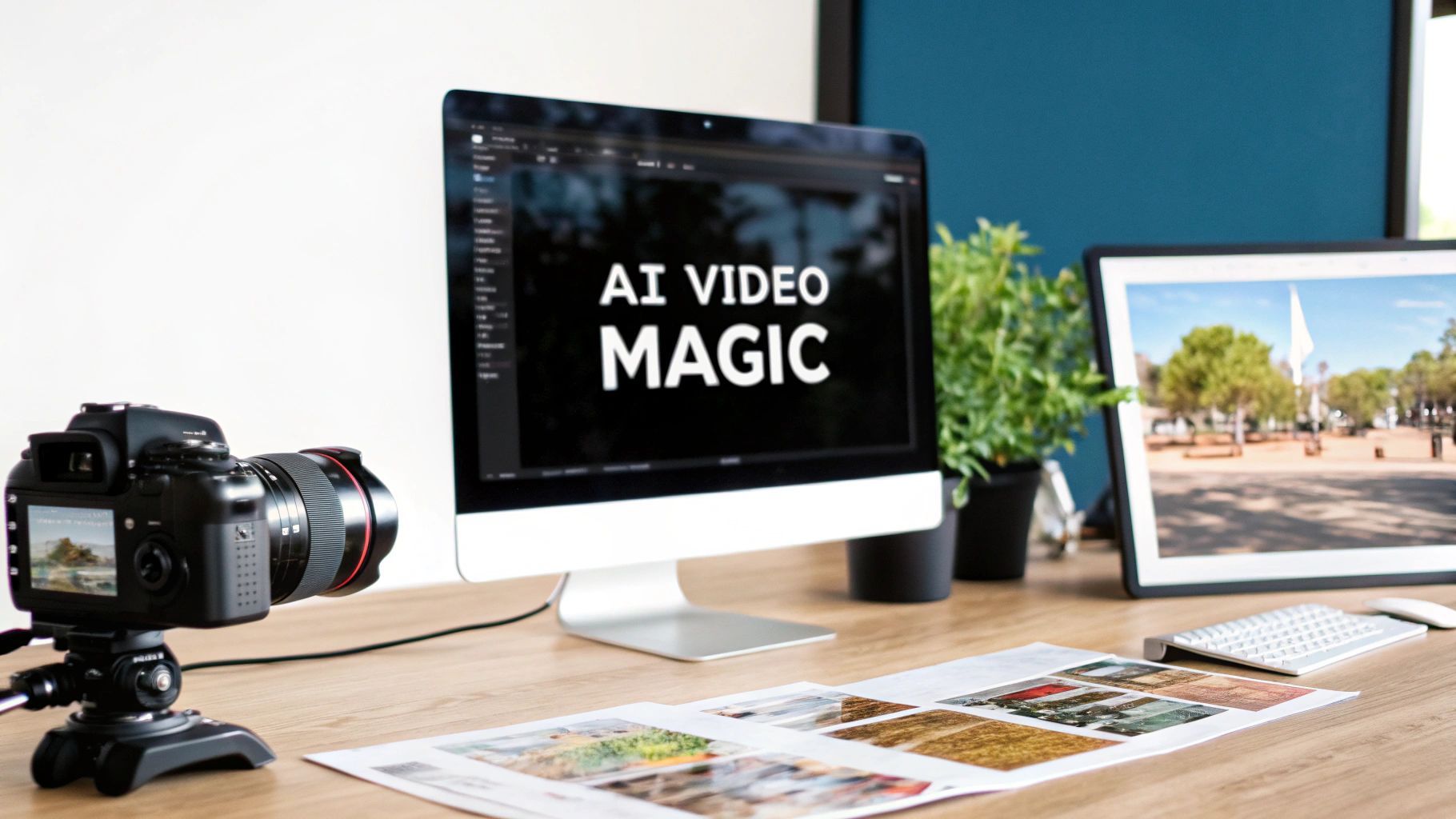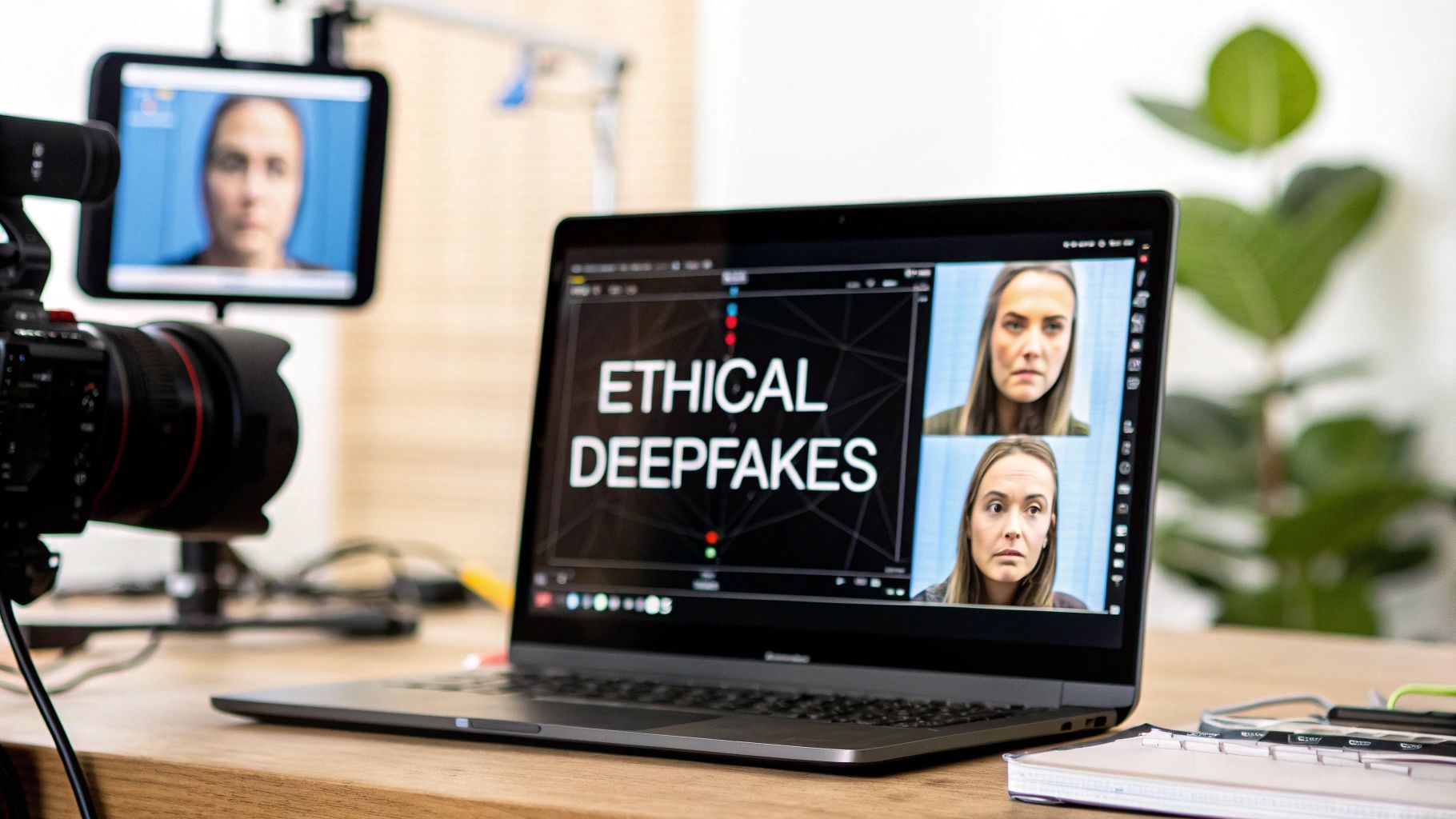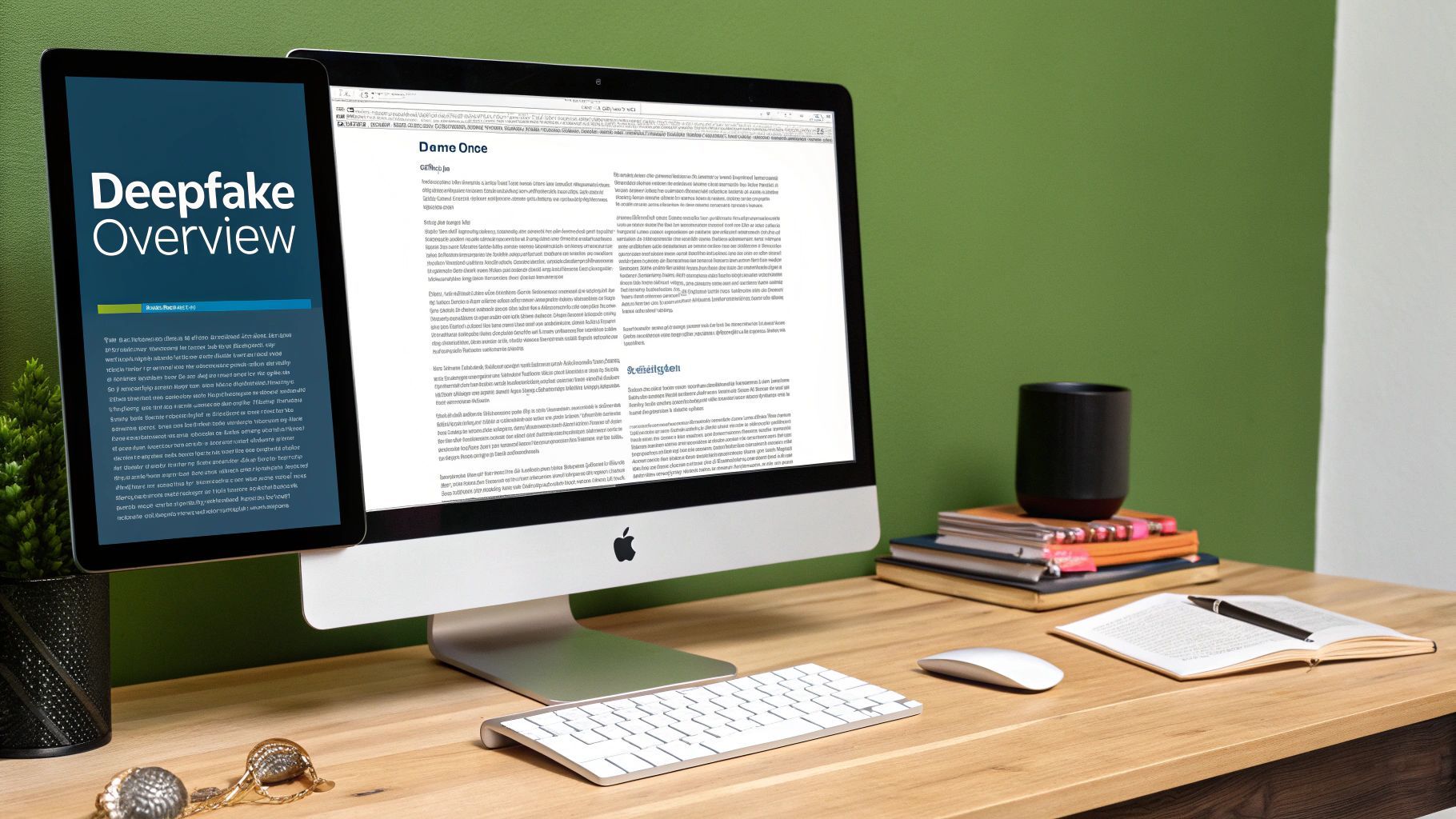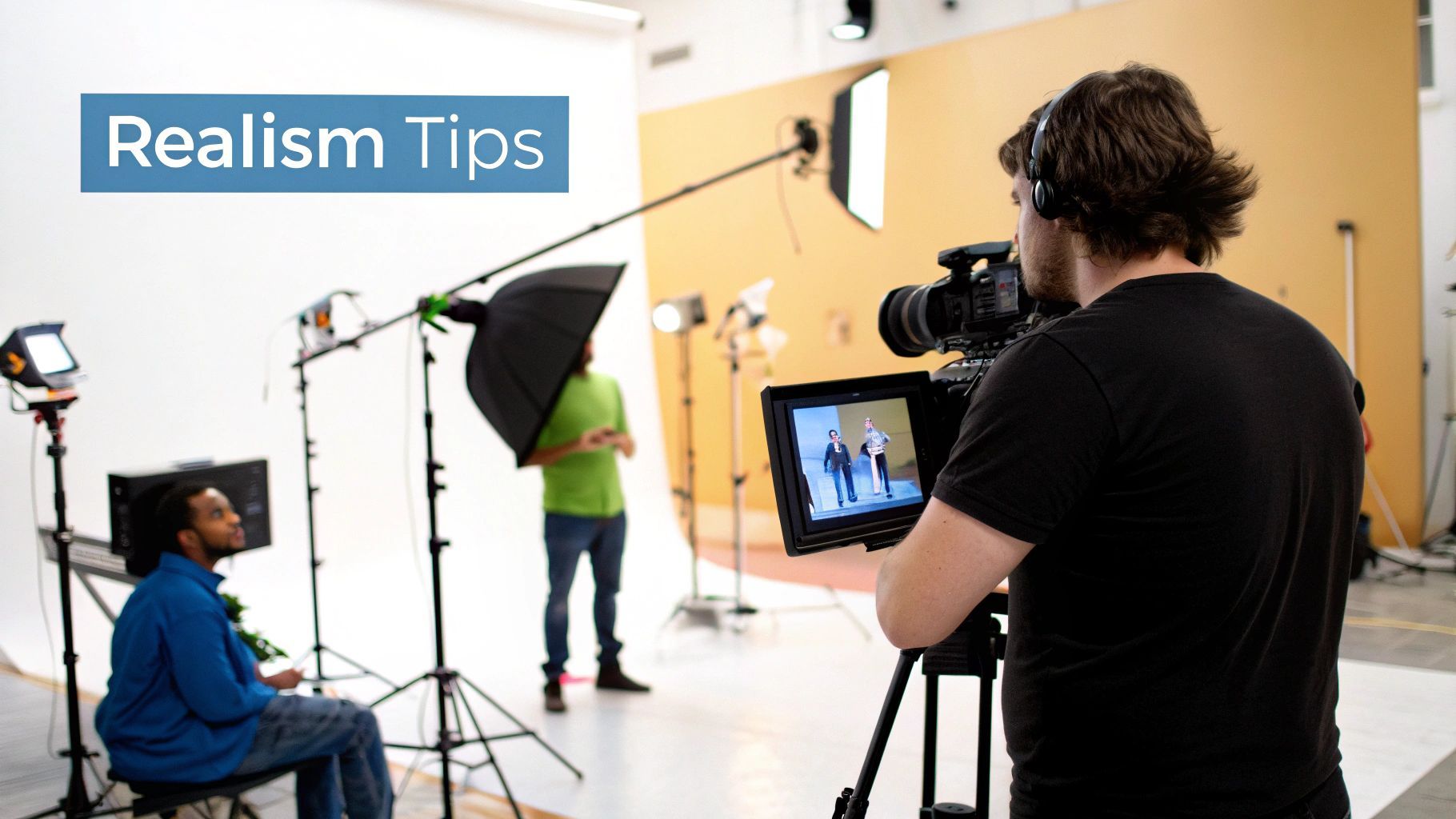Best Image to Video AI Generator – Create Stunning Videos Easily




Discover how to make deepfake videos with this fun and ethical guide. Learn about the best AI tools, sourcing footage, and creating your first project.
Ever stumbled across a video of a celebrity in a movie they definitely never made? That’s the wild, mind-bending world of deepfakes—AI-powered tech that convincingly puts one person's face onto someone else's body. And guess what? This isn't just Hollywood-level wizardry anymore. It's a surprisingly accessible tool you can get your hands on right now.

So, let's pull back the curtain on how these things are actually made. At its heart, a deepfake is just a video where artificial intelligence has surgically replaced a person’s face with someone else’s. The result is a seamless and often shockingly realistic new video. Think of it as high-tech digital puppetry, with an AI model pulling the strings.
This stuff has come a long way from its early days in academic labs. While the term "deepfake" is pretty new, the core idea has been around for a while. The trail really begins with a 1997 program called 'Video Rewrite,' which first figured out how to alter someone's mouth movements in a video to sync up with new audio. It was originally meant to make movie dubbing less awkward, but it planted the seeds for the powerful tools we have today.
Modern deepfake creation breaks down into a few key phases, taking you from a pile of raw footage to a polished final clip.
Data Collection: It all starts with gathering high-quality videos. You need clips of the "source" face (the one you're adding) and the "destination" video (the one you're putting it into). Model Training: This is where the AI gets to work. You feed it thousands of images from your data, and it learns every nuance of the source person’s facial expressions and movements. Video Synthesis: Finally, the trained AI model is unleashed on the destination video, meticulously swapping the face, frame by painful frame.
The engine running this whole show is a sophisticated branch of AI known as deep learning, which is itself a part of the wider field of machine learning. The AI pores over massive datasets of faces, studying everything from the way an eye crinkles to the unique shape of a smile, all to understand what makes a specific person look like them.
It's a game-changer for creators, offering a powerful new tool for parody, art, and entertainment. However, this creative potential comes with a crucial responsibility to use it ethically and transparently.
If you want to really get your head around the brains behind deepfake tech, exploring the core principles of machine learning provides a solid foundation. This journey doesn't start with writing complex code; it starts with understanding what the technology is, what it can do, and—most importantly—the ethical lines that should never be crossed.
Before you even think about stepping into the director’s chair, getting a handle on both the creative possibilities and the ethical guardrails is your first and most critical move.

Before you can even think about directing your first AI-powered video, you’ve got to assemble your toolkit. This isn't just about software; it’s about having the right hardware to power your creative ambitions. Think of it as setting up your digital studio.
First things first, let's talk about the heart of your operation: the graphics card, or GPU. This isn't just for blasting through the latest video games. A powerful GPU is the engine that does all the heavy lifting for deepfake creation, specifically the grueling process of training the AI models.
Why is it so important? Training an AI is a marathon of millions upon millions of complex calculations. Your computer’s main processor (the CPU) would take an eternity to get the job done. A high-end GPU, however, is built for exactly this kind of parallel processing, and it can slash your training times from weeks down to just days or even hours. It's the difference between a fun project and a frustrating slog.
With your hardware sorted, it's time to pick your creative weapon of choice. The software you land on will shape your entire workflow, dictating everything from how you prep your clips to the final polish on your video. The options really boil down to two main camps, each with its own distinct flavor.
On one side, you have the DIY route with open-source software like DeepFaceLab. This path gives you god-tier control over every single parameter. It’s a dream for tinkerers and tech nerds who love getting their hands dirty and understanding how the magic really happens. Just be warned: the learning curve is steep, and you'll need to get comfortable with command-line interfaces.
On the other side, you've got slick, user-friendly platforms designed to get you from concept to a finished video as painlessly as possible. No technical headaches, just creative flow.
The right tool for you comes down to one question: Are you here to learn the nitty-gritty mechanics, or do you need a great-looking video for a project with a deadline? Your answer will point you in the right direction.
The world of deepfake tools has absolutely exploded since around 2018, mostly because accessible software hit the scene. This opened the floodgates for both amazing creativity and, unfortunately, some serious misuse. The demand is undeniable—the development of new deepfake tools shot up by 44% in 2023 alone. You can dig into the tech's evolution and its impact in this deep dive from IBM.
Picking the right software can feel overwhelming, so I've put together a quick comparison to help you figure out where you fit in. This table breaks down the main types of tools available, from easy-to-use web platforms to more complex, hands-on applications.
A comparison of popular deepfake creation tools to help you pick the right one for your needs, from beginner-friendly online platforms to advanced desktop applications.
| Tool | Best For | Technical Skill Required | Key Feature |
|---|---|---|---|
| SendFame | Beginners, quick projects, content creators | Low. Simple upload-and-click interface. | Speed and ease of use. Handles all the complex processing for you. |
| DeepFaceLab | Hobbyists, researchers, advanced users | High. Requires patience and comfort with technical setups. | Unmatched control over AI training and merging. |
| FaceSwap | Intermediate users, those wanting a balance | Medium. GUI-based but with many advanced settings. | A solid middle ground between control and usability. |
Ultimately, the best tool is the one that gets you creating. For most people just dipping their toes in, an online platform is the perfect starting point.
Services like the SendFame AI video generator are built from the ground up to deliver incredible results without needing a computer science degree. You get to skip the technical setup and focus on what matters: the creative vision. Let their powerful servers handle the demanding AI training while you work on your idea. It's a fantastic way to learn the ropes of what makes a good deepfake before getting lost in the weeds.
Alright, let's get into the nitty-gritty. Every mind-blowing deepfake you've ever seen stands on the shoulders of one thing: great footage. You can have the most sophisticated setup on the planet, but if you're working with grainy, poorly-lit clips, you're going to get a hot mess. Seriously, this is where the real magic begins, long before you even touch the AI.
Think of yourself as a casting director. You're not just grabbing random clips; you're carefully selecting your stars. You’ll need two key players for your production:
The Source: This is your leading actor—the person whose face you're "borrowing." You're going to need a whole library of their expressions. The Destination: This is the movie clip or video that serves as your stage, where the face-swap will take place.
Your mission here is to build a top-tier collection of video assets. The cleaner, clearer, and more varied your clips are, the more data the AI has to work with, and the more seamless your final result will be.
Time to put on your detective hat. You're on the hunt for high-resolution video of your source person. The gold standard is a well-lit interview, a vlog, or any footage where their face is front and center, full of expression.
Don't just grab one clip and call it a day. You need to capture a whole range of angles and emotions. The AI is like an artist's apprentice—it needs to study the face from the front, in profile, and every angle in between. It needs to see them smile, frown, raise their eyebrows, and speak. The more comprehensive your library, the better the AI can rebuild their likeness in a new scene.
The old saying "variety is the spice of life" is the gospel here. A single, static video just won't cut it. The AI needs a complete visual dictionary of a person's face to do its job right.
Be ruthless about quality control. Ditch any clips with bizarre lighting, deep shadows, or anything blocking the face, like a hand or a microphone boom. These things just confuse the software and lead to those glitchy, uncanny valley results that scream "fake."
Now for the fun part—picking the scene for your grand experiment. This decision is just as crucial as sourcing your actor's face. The best swaps happen when the original actor and your new one share a few key similarities.
Look for a destination clip where the on-screen person has a comparable:
Facial Structure: If your source has a round, soft face, trying to map it onto someone with a jawline that could cut glass is going to look… off. The AI is good, but it's not a miracle worker. Lighting Conditions: This is a big one. A face filmed under harsh studio lights will stick out like a sore thumb in a dimly lit, moody bar scene. Match the lighting as closely as you can. It’s what sells the illusion. Head Movements: Wild, jerky head movements are the bane of any deepfake project. They're incredibly tough for the AI to track smoothly. For your first few attempts, stick to scenes with calmer, more predictable motion.
It’s not about finding an identical twin. Think of it more like casting a stunt double—they don't need to be a perfect match, but a similar build and physical presence make the final performance believable.
Got your clips? Great. Now it's time for some basic prep work. This isn't just busywork; it's what separates a smooth process from a frustrating one. Fire up a simple video editor and start trimming the fat.
There's no reason to make the AI chug through a two-hour film. For your source clips, isolate just the moments where the face is clear and expressive. For the destination video, cut it down to the exact scene you plan to use. Trust me, this will save you a massive amount of processing time.
Finally, a quick bit of housekeeping: make sure your videos are in a common format like .MP4. Most deepfake tools play nice with standard formats, and trying to use something obscure is just asking for errors. A few minutes of prep here will save you hours of headaches later, letting you get back to the creative part.
Alright, you’ve got your pristine footage and your tools are fired up. Now for the fun part—the digital alchemy where all your prep work pays off. This is where we take your raw clips and spin them into a finished deepfake.
To keep things from getting too technical, we’ll use a platform like SendFame as a mental model. The whole process really just boils down to a three-act play: you extract faces, you train the AI, and then you merge it all together. It sounds complicated, but think of it as a digital assembly line.
Before the AI can do its thing, you need to feed it. But you can't just toss it a video file and hope for the best. The software needs to isolate and study only the face from your source video. This curated collection of face shots is what we call a faceset.
Imagine you're creating the world's most detailed photo album of one person, capturing every possible angle, expression, and lighting condition. That's essentially what you're doing here. The software automates this by meticulously scanning your source video frame-by-frame, detecting the face, and snipping it out. A solid faceset can have anything from a few hundred to several thousand individual images.
Most modern tools handle this extraction for you, but the real pros know that a little manual cleanup goes a long way. Take a few minutes to scroll through the extracted faces and be ruthless. Delete any blurry shots, frames where the face is partially hidden, or images with bizarre lighting.
A clean, high-quality faceset is the absolute bedrock of a believable deepfake. Garbage in, garbage out.
This image breaks down the entire workflow into its three core stages.

As you can see, it's a logical flow. Each step builds directly on the one before it, from data prep to the final render.
With your faceset ready to go, the real AI magic kicks off. This is the training phase. The algorithm pores over every single image you gave it, learning the unique topography of the source face—the exact shape of the eyes, the subtle curve of a smile, the way light dances on the cheekbones. It's building an incredibly complex mathematical blueprint of that person's likeness.
Be warned: this is by far the most time-consuming part of the whole affair.
Depending on your hardware (or the cloud servers you're renting), training can take anywhere from a few hours to several days. The AI is running through countless learning cycles, or iterations, getting a tiny bit smarter each time. Early on, the generated faces will look like nightmarish, blurry blobs. But as the iterations climb into the tens of thousands, a recognizable—and increasingly realistic—face will start to emerge from the digital noise.
The tech that makes this possible is a type of AI called a Generative Adversarial Network (GAN). This architecture is the engine behind most modern deepfakes. Nvidia really pushed the envelope here by training models to generate faces in stages, starting with a low-res image and progressively adding detail. This leap forward is what took deepfakes from janky face-swaps to the photorealistic videos we see today. You can get a great breakdown of this history from this overview of GAN development.
Once you're happy with the trained model, it's time for the final act: merging. This is where you apply your AI model to the destination video. The software chugs through the target clip frame-by-frame, finds the original face, and paints your new, AI-generated face right on top of it.
But it’s not just a simple copy-paste job. This is where your inner artist needs to come out and play with the settings to sell the illusion.
You’ll want to fine-tune a few key things:
Color Matching: Tweak the skin tones and color balance so the new face doesn't stick out like a sore thumb. It needs to look like it belongs in the scene's lighting. Mask Blending: Soften the edges where the fake face meets the real footage. A hard edge is a dead giveaway, so you want a seamless, feathered blend. Occlusion Masking: This is a big one. It makes sure that when something passes in front of the face—like a hand waving or someone walking by—it correctly layers over the deepfake, not behind it.
Nailing these final adjustments is what separates a clumsy fake from a truly convincing one. Once you've got everything dialed in just right, hit that render button. And just like that, you've officially brought your first deepfake to life.

So, you’ve hit the render button. That feeling of seeing your deepfake come to life is pretty awesome, but hold on—don't pop the champagne just yet. The raw output is your foundation, but the magic that makes people do a double-take happens in the final polish.
This is also the moment to put on your ethics hat. Seriously. Making deepfakes is more than just a cool tech trick; it's a creative responsibility. Let's walk through how to add that pro-level finish while making sure your masterpiece is impressive for all the right reasons.
Your freshly baked deepfake probably looks solid, but a few simple tweaks in a video editor can take it from "pretty good" to "whoa, how did you do that?" You don't need a Hollywood-tier software suite; a basic editor will get the job done.
First up, let's talk color matching. Even the smartest AI can leave the swapped face looking a little… off. Maybe the lighting is a bit warmer or the saturation is a touch different from the original scene. A quick, subtle color correction is all it takes to make the face feel like it truly belongs there.
Next, hunt down the seams. Zoom in and look at where the new face meets the hair and neck. See that faint line? That's the dead giveaway. A gentle blur or a feathering effect applied right along that edge can completely erase that tell-tale sign of digital surgery. It's a small detail that makes a massive difference.
This final 10% of effort is what makes 90% of the difference. A little post-production polish is the key to transforming a technical success into a work of art that captures the imagination.
And please, don't forget the audio! A silent video is just weird. Adding a killer soundtrack, some well-placed sound effects, or a voiceover is what truly sells the illusion. If you're creating a parody music video, for instance, the audio is at least half the joke. If that's your jam, our guide on how to make music videos has some fantastic pointers for syncing everything up.
Alright, let's have a serious chat. This technology is a double-edged sword. In the right hands, it’s a tool for incredible comedy and art. In the wrong hands, it can cause real harm. Navigating this isn't about killing your creativity; it's about making sure your fun doesn't come at someone else's expense.
Think about this: recent analysis shows that over half of businesses in the US and UK have been hit by financial scams that use deepfake tech. That one stat alone shows why we, as creators, have to build on a solid ethical foundation.
Here are a few ground rules to keep your projects on the right side of the line:
Consent Is Non-Negotiable: Never, ever deepfake a private person without their enthusiastic, explicit permission. For public figures, keep it to satire and parody that clearly falls under fair use. Don't Be a Villain: Your goal should be entertainment, art, or education. Using this tech for bullying, spreading lies, defamation, or fraud isn't just unethical—it's often illegal. Be Upfront About It: Whenever you can, just let people know it's a deepfake. A simple watermark or a quick note in the description builds trust and stops your work from being passed off as real.
Before you unleash your creation upon the world, it's worth running it through a quick mental filter. This simple guide helps ensure your project stays creative, responsible, and harmless.
| Ethical Guideline | Why It Matters | Practical Application |
|---|---|---|
| No Non-Consensual Content | This protects real people from harassment, embarrassment, and reputational damage. It’s the golden rule. | Don't use photos of friends or family without asking. Stick to public figures for parody, and even then, be thoughtful. |
| Avoid Deception and Fraud | This stops the tech from being used to create fake evidence, scam people, or manipulate opinions. | Never create a video to impersonate someone for money, influence an election, or put false words in their mouth. |
| Label Your Creation | It helps your audience understand what they're seeing and prevents bad actors from using your fun clip as misinformation. | Add a simple "#deepfake" or "#parody" to your description or a subtle watermark on the video itself. |
| Respect the Individual | Even parody has its limits. The goal is to be clever and funny, not cruel or demeaning. | Focus on the situation or persona, not on launching a mean-spirited attack. Keep it light and in good fun. |
At the end of the day, we’re all shaping how this technology is perceived. By focusing on harmless fun, cool art, and clever entertainment, you help build a culture where deepfakes are seen as an amazing tool for creativity, not a weapon. So go make something awesome, make something funny—but above all, make something that does no harm.
Alright, let's get into the nitty-gritty. If you’ve still got some questions bouncing around your head, you’re in the right place. We'll clear up the common hurdles and curiosities that pop up when you're first diving into the world of deepfakes.
This is always the first question, and for good reason. The short answer is: it all boils down to your intent.
Making a deepfake for a harmless parody, a mind-bending piece of digital art, or just for a laugh with your friends? You're generally in the clear. The legal red flags and ethical alarm bells go off when the purpose is malicious.
Think fraud, defamation, harassment, or creating non-consensual explicit material. That’s not just unethical; it's illegal in many places. The rule of thumb is simple: if your aim is to hurt, humiliate, or deceive someone for your own gain, just don't do it.
The classic "it depends" answer really applies here. If you're using a slick, cloud-based platform, you can go from a cool idea to a finished video in just a couple of hours. These tools are built for speed and do all the heavy lifting behind the scenes.
But if you’re a purist and go the open-source route? You're in for a much longer haul. Just training the AI model can take days—or even weeks—of non-stop work on a beefy computer to get that seamless, ultra-realistic look. You're trading time for granular control.
I see beginners make one mistake over and over: they feed the AI garbage footage. If the lighting is different, the head angles are all wrong, and the faces don't even have a similar structure, the AI is going to choke. Your software can be top-of-the-line, but it can't work miracles with mismatched source material.
Not anymore, thankfully! The days of needing a server farm in your basement are long gone. While the big Hollywood-level deepfakes are still cooked up on massive GPU clusters, you can get incredible results without that kind of firepower.
Plenty of fantastic online tools handle all the processing for you, meaning you can create some seriously impressive videos from a standard-issue laptop. If you do want to run the software locally, a decent gaming PC with a modern graphics card will get the job done.
Absolutely. The deep learning magic behind deepfakes is making waves across all sorts of creative fields, especially in music. AI is now being used to generate completely new melodies, master tracks, and even create entire soundscapes from scratch.
It’s a fascinating crossover of art and technology. If that piques your interest, you should definitely check out these amazing AI tools for musicians that are completely reshaping the industry.
Ready to skip the command lines and endless rendering times? SendFame gives you an incredibly powerful yet simple platform to create professional-quality AI videos in minutes, not weeks. Jump in and start bringing your wild ideas to life at https://sendfame.com.
Create Epic
SendFame